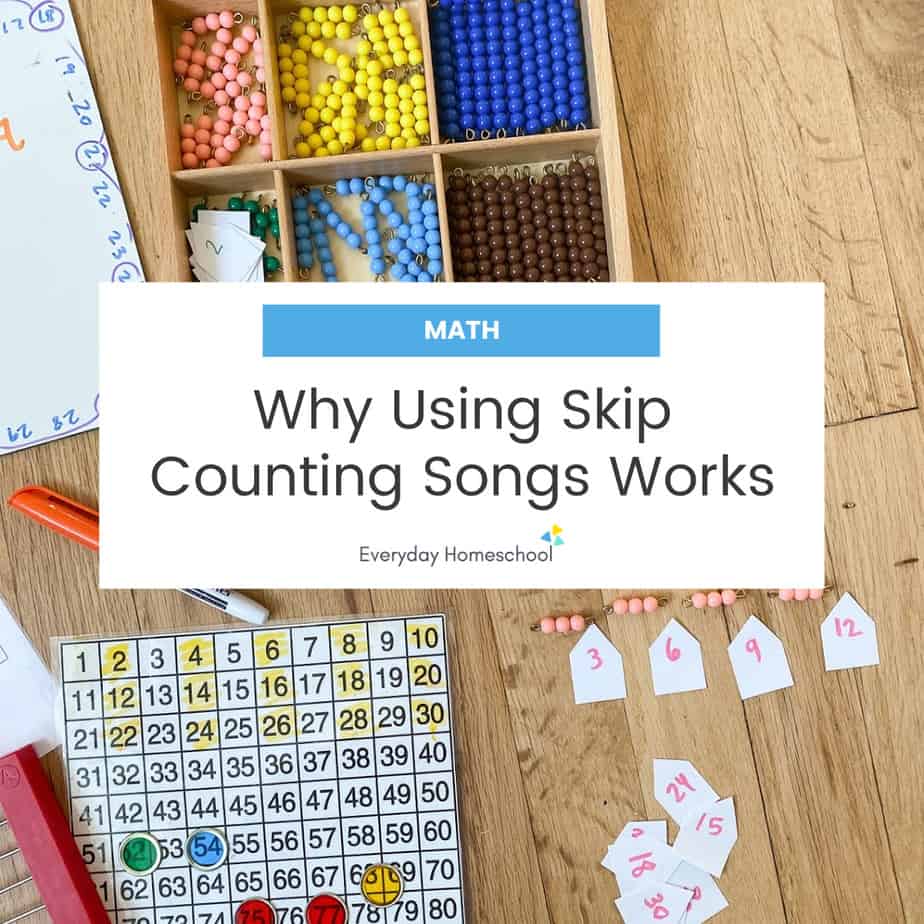In this post you’ll learn why skip counting for 4-8 year olds is key to helping kids master multiplication and division as they get further in their math studies.
You’ll also learn why songs make skip counting easy & how to make up your own skip counting songs.
Or, you can download our short, simple skip counting songs that are super easy for kids to learn & remember!
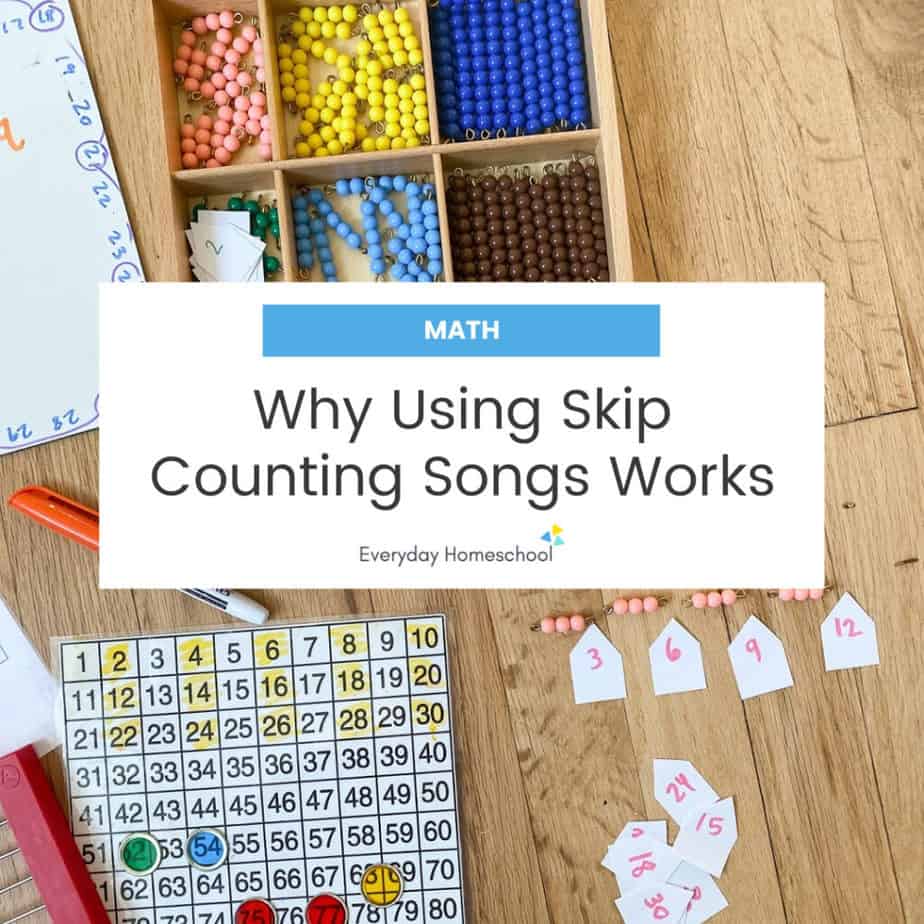
Why Skip Count?
1. Important Skill for Math Fluency
Skip counting is the precursor to learning multiplication tables. Learning to skip count before learning the concept of multiplication helps students master multiplication facts more easily down the road. Skip counting songs set the students up for success in counting anything in groups – time, money, dividing by equal groups, fractions, etc.
Having the skip counting number sequences at the tip of your tongue accelerates understanding in harder concepts (and math facts) down the road.
2. Makes Learning Time & Money Easier
MONEY
Think about being 6 years old and learning that nickels are worth 5 cents.
The whole concept of money is abstract for a young child. The idea that these coins (which look like toys) & pieces of paper are exchanged for valuable goods… it’s pretty abstract to begin with.
Plus, most people pay with debit or credit cards nowadays. Many young children barely ever seen someone paying cash & change for something. Then, they learn there are actually 4 coins: one is worth 1 cent, one is worth 5 cents, one is worth 10 cents, and the big one is worth 25 cents.
But the child doesn’t really know what cents are, and he doesn’t know how to count by 5s or 10s or 25s.
So now they have to understands the concept that the coins are worth arbitrary amounts AND have to learn how to count by 5s, 10s, and 25s simultaneously.
That’s a lot to learn at once.
Imagine, on the other hand, that the child already knows how to count by 5s, 10s, and 25s. He learned a little song or chant when he was 4 or 5 years old. At the time, he had no clue what the numbers meant but the tune was fun so it stuck in his brain.
You sit down for the introduction-to-nickels lesson. You explain different coins are worth different amounts. You demonstrate counting pennies by 1. (Perhaps the child already learned that in kindergarten.) Then you demonstrate that nickels are worth 5 cents and we count nickels by 5.
You pull out 12 nickels and as you slide each one across the table, you say “5-10-15-20-25-30” etc. The child joins in because they already know how to count by 5s (and probably take pride/ joy in it because it feels fun to them at this age!)

He copies you and slides the nickels across the table, successfully counting by 5s. You encourage: “Yep! 60 cents. Great counting by fives. We can buy a piece of candy for 60 cents or 100 cents. Let’s bring some nickels with us to the store next time and we’ll count our nickels by fives to buy a piece of candy.”
They still don’t 100% understand the entire abstract value system of money, but they know that the thickest, medium-size silver coin gets counted by 5s and that they can count it! (And that being able to do this in a store will result in candy – haha)
Learning to count money is much easier for a child who already knows how to skip count.
TIME
The exact same principle applies to learning time on a clock.
Learning to tell time on a clock and understanding the basic principles of time are much easier for a child who already knows how to skip count. Time, like money, is also very abstract!
- 15 minutes is a quarter of an hour.
- 30 minutes is half an hour.
- There are 24 hours in a day divided into 2 repeating sets of 12.
- The numbers on an analog clock are numbered 1-12, but they are counted by 5s.
WHAT?! That is confusing!!
SKIP COUNTING MAKES IT EASIER THOUGH!

I have now taught my own children time, money, and eventually multiplication with relative ease. They all get it because we used math programs that developed good number sense & because they learned to sing skip counting songs when they were 4-5 years old.
I’ve observed the same thing play out for countless homeschool families in our co-ops and hybrid schools. The kids who knew how to skip count early on picked up the harder math concepts more easily as they went through their math education.
Why Use Songs!?
1. Music Sticks
We all have quickly learned the lyrics to a song that was played over and over. Music sticks.
Volumes of memory science & neuroscience research prove this, and you can read about that if you love to nerd out like that.
But the bottom line is, we all know that if something is sung, we are way more likely to remember it – commercial jingles, church songs, children’s songs. Chances are that when you had your own young children, you remembered Mary Had a Little Lamb from your childhood even though you hadn’t sung it in 25 years!
Young children’s minds are like sponges. They memorize things so much easier than adults! (Again, the neuroscience research on this is interesting, if you’re into that sort of thing.)
We already discussed why skip counting will be helpful for a child’s math success as they get older! Knowing this, why not give them an almost effortless way to learn how to skip count with songs?!
RELATED POSTS: Skip counting by 4 song & activities, skip counting by 8 song and activities
2. Fast, Easy & Fun Way
Learning counting songs is probably the easiest way to learn skip counting. No drama or tears or hours of practicing flashcards necessary.
I’ve seen many Youtube Videos with 3-4 minute longs songs reciting every multiplication fact from a given times table. There are flashing lights & silly pictures, but it just seems long & boring. Plus the tunes are often so repetitive that it would be easy to mixup the facts.
If you watch those videos for 3 minutes each times 12 tables, that’s 36 minutes a day… BORING. (Although very good for the advertising revenue!)
Using a short skip counting song, on the other hand, takes 15-30 seconds per song. With our children, we’ve learned 2 per week. We might play the song a couple times in a row at the beginning of math time. That takes 1 minute max, including the time to unlock your phone & open the song. It’s an easy & engaging way to begin the math lesson.
(And once you know them, you can review them anytime, anywhere with or without the actual song.)
3. Familiar Tunes are More Memorable
If you use time-tested folk & children’s songs with a memorable melody, or super catchy pop hits, the songs are often stickier & easier to remember too.
Plus, you can easily start singing the skip counting tune at the dinner table and anyone will recognize it. The familiarity breeds memorization.
Our songs use familiar tunes like She’ll Be Coming Around the Mountain and Happy Birthday.
What Skip Counting Songs to Use
You can totally come up with your own skip counting songs! Here’s how:
- Decide how high you want the child to count. (Our songs go up to 12 x 12.)
- Think of simple nursery rhyme tunes or catchy songs your kids know – This Old Man, Mary Had a Little Lamb, Jingle Bells, London Bridge, 10 Little Indians, etc.
- Match up the numbers to a portion of the tune.
Or just download ours!! 😊
We have a skip counting album that you can download here.
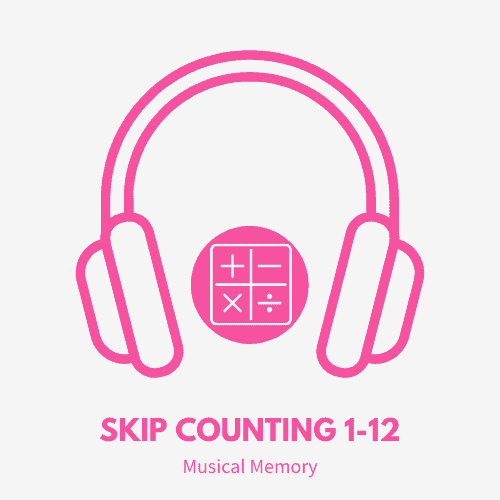
How to Teach with Skip Counting Songs
Wee Little Ones (Under 5)
There is no need to practice or teach this age group math songs. They’re just along for the ride. If you have older kids, the little ones who are around listening will subconsciously internalize the tunes and numbers.
The power of music in the memory is AMAZING! I guarantee if you start playing skip counting songs for your older children, the 1 and 2 year olds who happen to be around will spout them off in 5 years as if they’ve known them forever. (Because they have.)
Preschool, Kindergarten & 1st Grade (Ages 4-7 ish)
This age group of kids is mostly just memorizing random numbers. Most kids in this age group will not understand the concept of skip counting as grouping numbers together.
At this age, it is 100% about taking advantage of their little sponge-like brains that absorb EVERYTHING. They memorize pop songs, youtube videos, and favorite movies. They might as well memorize skip counting songs.
It’s popular to talk about how to teach critical thinking to young children… but, kids can’t think critically about something they don’t know. If you want to build a strong number sense & math fluency for concepts like equal groups, place value, number patterns and times tables, play the skip counting songs to your 4-6 year olds.
Just play the songs on repeat for this group. Don’t worry about instructing kids this age in skip counting*. (*exception explained a couple sections below)
TIP – CORRECT NUMBERS & PRONUNCIATION
For the first several times they hear the songs, kids this age might try to sing along and get some of the numbers wrong. That’s okay.
But if you notice that a child CONSISTENTLY says for example, “24, 21” instead of “21, 24” while counting the threes, pause the song & correct their order.
Sing the numbers slowly in the correct order & let the child practice a few times. You don’t want them to internalize the numbers in the wrong order 😊
NOT AN INSTRUCTIONAL FOCUS
Spend most math instruction for kindergarten & first graders in a solid math curriculum, most of which will focus on number sense, addition, subtraction, ones and tens, mastering addition facts, etc. Simply playing the songs is a grade-appropriate level of rigor. There is no race to learn abstract concepts.
Just play the songs, encourage them to get the numbers correct over time, and in a few years when the child learns to multiply, you will see the payoff! I promise!
*THE EXCEPTION BEING…
…if the child figures it out. I still remember my 6 year old figuring out she could count groups of objects by twos.
Her ah-ha moment led to lots of self-directed practice counting snacks on her plate and toys on the floor and piles of library books, etc. She eventually made the connection that she could count by 3s and 4s etc because of the songs.
BUT… if the child doesn’t make the connection on his own, don’t worry about explaining how it actually works, practically speaking. It’s okay that he is just rote memorizing at this point.
Counting groups of objects accurately is a more advanced skill & the child will more quickly learn grouping with the skip counting songs in their brain.
IF YOU HAVE A YOUNG CHILD WHO “GET’S IT”
If you have a 5 or 6 year old child who starts to figure out that numbers of objects grouped in 2s or 3s match up with the skip counting songs, you can do a little bit of teaching at this time.
As I said before, do not force this too young…if you do, it’ll be confusing to the child.
But if the child happens to discover that his shoes, snacks, or memory match cards can be counted 2-4-6-8 [picture], praise the connection. “You’re right! That’s the 2s song. We can add some more and keep counting too.” Then demonstrate how to go up to 10-12-14-16 etc.

Then just move on with life.
But, start noticing opportunities to point out groups of 2s to reinforce the connection he just made.
All math should be learned concretely (hands on) first, so resist the urge to bust out a worksheet that shows objects in groups of twos, like above.
Instead, next time you dish out pancakes or cookies, put 2 on each plate & ask the child if he can count the snacks by 2s. Or maybe there is a house in your neighborhood with symmetrical windows across the front. Point out that the windows look like they’re in groups of 2s and see if he can count them.
In this way, you’ll reinforce the child’s own discovery about how the skip counting song worked to count actual objects. That real-life-hands-on discovery will pay off dividends in the child’s future math fluency.
Skip Counting for 2nd, 3rd, and 4th Graders
2nd grade (or 3rd grade) is the age a lot of kids start practicing the actual concepts of counting numbers in groups. Their math curriculums are having them count things by 3s. They’re learning to identify that 4 groups of 3 makes 12 objects.
They’re practicing word problems & math stories like, Devon reads 3 books a day for 1 week. How many books does he read in a week? (These types of math problems come up a TON in second grade math curriculums as a precursor to actually learning multiplication facts because they are great practice for understanding the concept of counting equal groups.)
You and I can figure that out easily because we know that there are 7 days in a week and 3 x 7 = 21… it’s second nature to us.
But imagine if the child knows there are 7 days in a week and that he should add 3 plus 3 up to the 7 days…. BUT, he has to count up by 3 for every day! He’s much more likely to lose track of the counting. Or have to tally it out and count the tallies.
He’s way more likely to get frustrated and bogged down just by the counting portion, even if he understands the concept of counting by groups of 3 for the answer.
On the other hand, the child who already knows how to count by 3s will simply start counting by 3s on their fingers until they reach 7 for the 7 days in a week. Probably, the child will sing, “3-6-9-12-15-18-21!!”
And they’ll probably cheer “21 books!” Because they totally understand how the skip counting works in that math problem AND it’s easy for them.
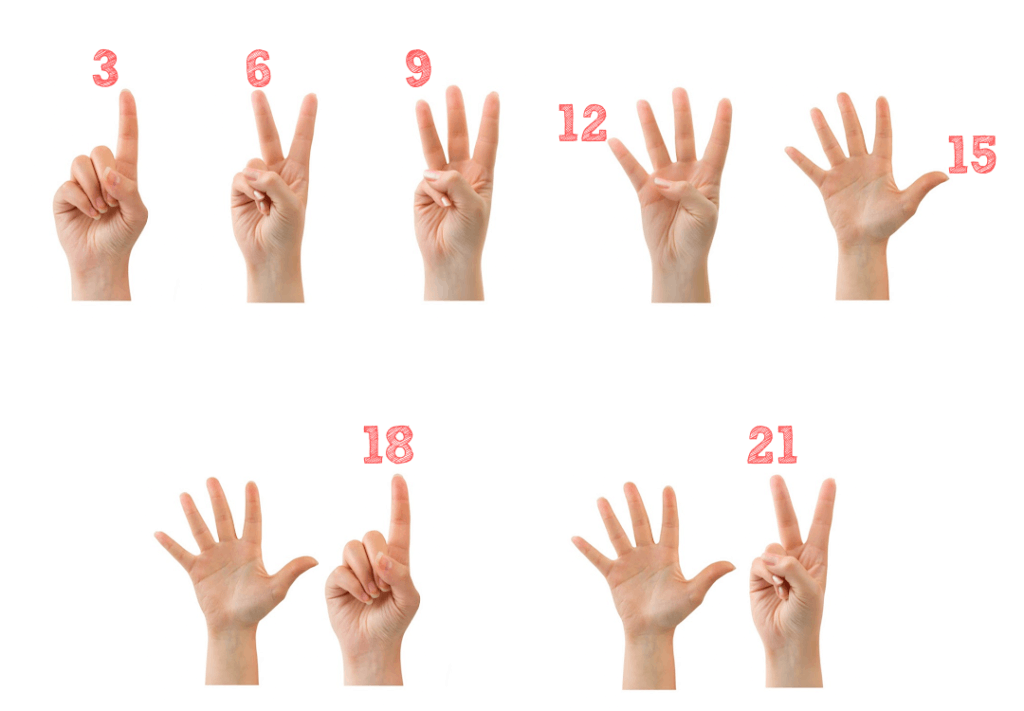
Makes Multiplication & Division Easier for Older Kids
I cannot overemphasize how much easier learning grouping, then multiplication, then division will be for a child who can skip count easily. If a child doesn’t have the skip counting on the tip of their tongue, they will be struggling to understand the concept of grouping AND they will be struggling to get the numbers correct.
The skip counting songs are the fastest way to learn the skip counting, hands down.
It’s best to learn the skip counting songs BEFORE your child is learning multiplication (typically mastered by third graders)… so the 4-7 year old window is the best time to get the songs down.
But the skip counting songs can still help students who are older. If you have an older kid who is having a really hard time with multiplication and division facts, play the songs.
- Incentivize the child to listen to them several times a day.
- Learn 2-4 songs a week and play them on repeat.
- Have your child write the skip counting numbers for each song out on a poster and follow along while the songs are playing.
- Have the child fill out a blank multiplication chart while listening to the songs.
- Use Montessori beads to make number chains as pictured below.
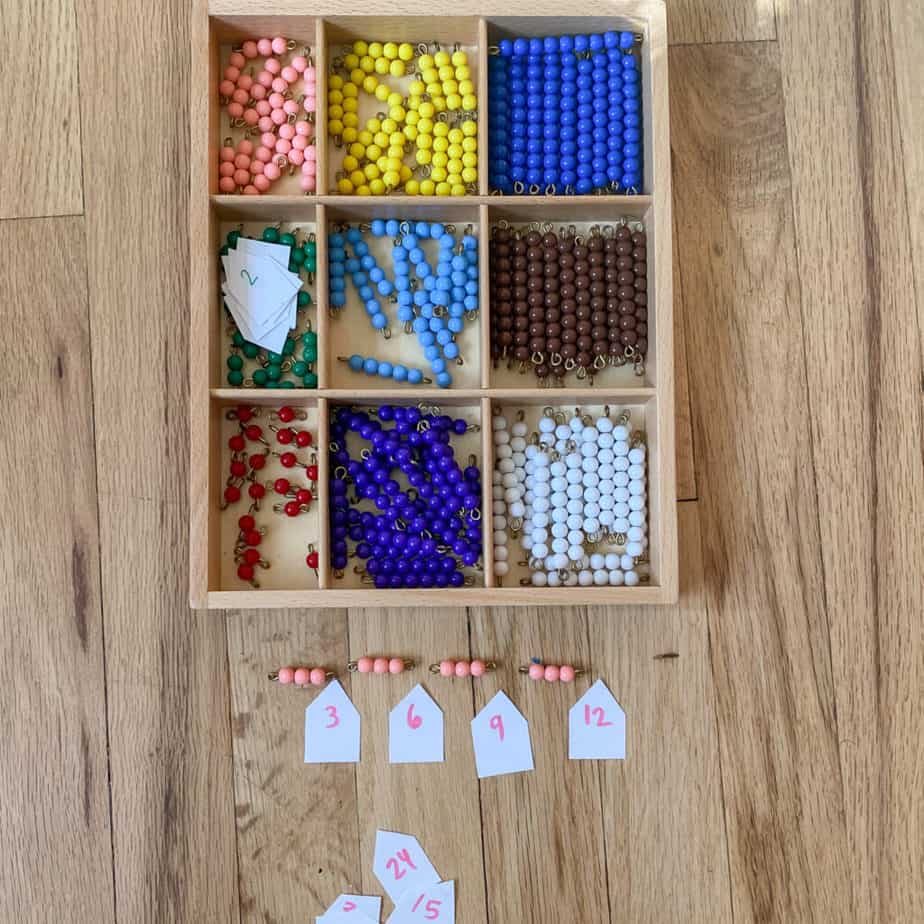
Grab the skip counting songs while they’re on sale! Then, head over to this post to learn more about how to teach skip counting.

